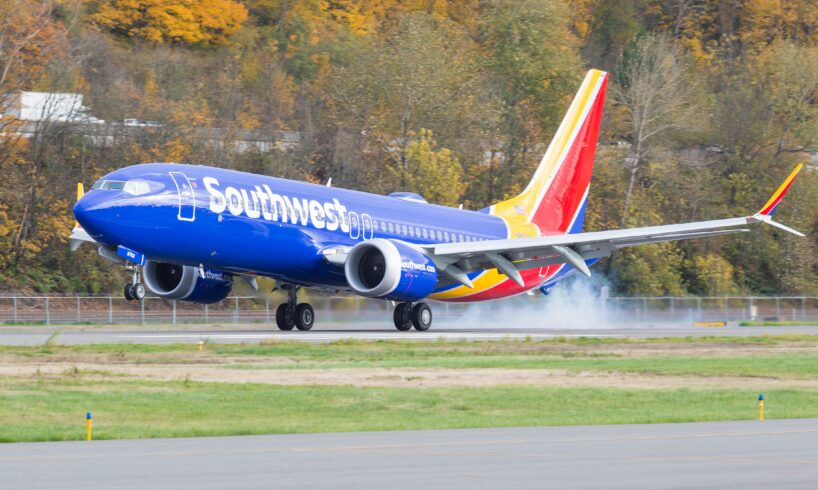
The United States Department of Transportation’s (DOT)
Office of Inspector General (OIG) has initiated an audit of the Federal Aviation Administration (FAA) and its actions in response to two Cabin Air Quality Events (CAQE) in 2023.
The two incidents, both involving Southwest Airlines Boeing 737 MAX 8 aircraft, did not result in any immediate safety action after the FAA’s Corrective Action Review Board (CARB) decided not to recommend interim changes to take-off procedures.
Auditing The FAA
Photo: Zaheed Elahi | Shutterstock
In a memorandum on April 16, the DOT’s OIG informed that it will audit the FAA’s
actions in addressing the risks from load reduction devices (LRD) activating during bird strikes on CFM International LEAP-1B engines, which exclusively power the Boeing 737 MAX
aircraft family.
According to the OIG, the audit’s objective is to assess the regulator’s actions in response to CAQEs, including when toxic smoke and fumes enter the aircraft’s cockpit or cabin when LRDs are activated. The office informed that the audit would begin in April and include visits to the FAA’s offices that were involved in the decision-making process related to the events involving LRDs.
In November 2024, the FAA told Simple Flying that on November 26, 2024, CARB held a meeting to discuss the issues surrounding LRDs on LEAP-1Bs, which led to smoke entering the cabin and/or cockpit. During the meeting, the board discussed several internal safety recommendations.
“Based on the available data, the CARB determined the issue does not warrant immediate action, and the FAA will follow its standard rulemaking process to address it. The FAA will issue a Continued Airworthiness Notification to the International Community (CANIC) about new information Boeing provided to operators of aircraft with LEAP-1B engines. The new information contains enhanced instructions that direct flight crews more quickly to the appropriate actions when they experience abnormal engine indications.”
Bird Strikes
Photo: BlueBarronPhoto | Shutterstock
The OIG detailed that in March 2023 and December 2023, two separate bird strike events damaged the engines of 737 MAX 8
aircraft, causing smoke and toxic fumes to enter the aircraft, putting lives in danger. These strikes fractured the aircraft’ engine fan blades, resulting in the activation of the LRDs, a design feature that reduces unbalanced vibrations caused by damage to the engine to help prevent further issues.
When the LRDs were activated during the two CAQEs, which is a term defined by the International Air Transport Association (IATA) as minor or major events involving odor events or the contamination of the air inside the aircraft, “a large amount of engine oil flowed into the hot section of the engine causing toxic smoke and fumes to enter the cockpit or cabin via the environmental and aircraft pressurization systems.”
In December 2023, the LRD activated in the left-hand LEAP-1B engine, which, according to the OIG, was concerning since smoke entered the cockpit and could have incapacitated the flight crew. In March 2023, the LRD activated in the right-hand side engine, sending smoke into the cabin, the office’s statement read.
Related
FAA Says No Immediate Fix Needed For Boeing 737 MAX Engine Smoke In Cabin After Bird Strike Incidents
The FAA was exploring whether to propose software changes that would change the way the LEAP-1B responded to a bird strike.
Larger Birds
Photo: Robin Guess | Shutterstock
The two CAQEs involved Southwest Airlines’
737 MAX 8 aircraft. In March 2023, one of the airline’s 737 MAX 8, registered as N8792Q, was departing on flight WN3923 from Havana José Martí International Airport (HAV) when it encountered birds, while in December 2023, another 737 MAX 8, registered as N8830Q, was operating flight WN554 from Louis Armstrong New Orleans International Airport (MSY) to Tampa International Airport
(TPA), when it suffered a bird strike. In December 2024, the National Transportation Safety Board (NTSB)
published a preliminary report about the latter event, detailing that CFM International and Boeing
have been developing a software design update.
In a statement to Simple Flying in November 2024, CFM International,
a joint venture between GE Aerospace and Safran Aircraft Engines, said that LRDs have been used in the industry for over 20 years and have operated as designed. The company had been working with the FAA, European Union Aviation Safety Agency (EASA),
and Boeing to determine any learnings from “recent events.”
According to CFM International, LRDs are a proven technology that meets all certification requirements and operates as designed to prevent hazards to the aircraft, reiterating that the LEAP engine family, which also powers the A320neo aircraft family as the LEAP-1A, meets FAA and EASA requirements. However, the spokesperson noted that the “birds in these incidents significantly exceeded the size and weight of regulatory bird ingestion certification standards,” yet the engines still performed as designed during the two incidents.





